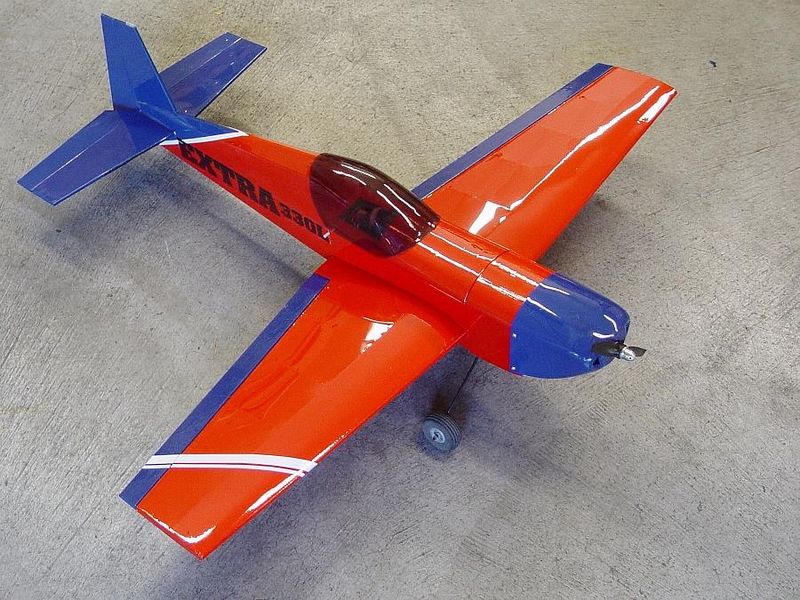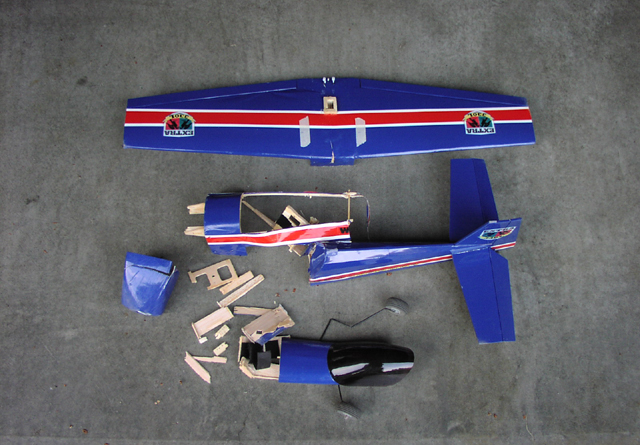Wattage Extra 330L

|
| Not a bad looker for 2003! |
General Specifications
Kit Manufacturer - Wattage
Aircraft - Extra 330L
Build Date - September 2003
| Airframe Type - | Mid Wing | Flying Type - | Pattern Sport | |
| Wingspan = | 32 inches (Dandy) | Length = | 27 inches | |
| Wing Area = | 200 sq. inches | All-Up Weight = | 23.2 ounces | |
| Motor - | Balsa Products BP2217-6 OR | Wing Load = | 16.8 oz/sq. ft. | |
| Propellor - | 7 x 6 APCe | Power = | 300 watts (Static) | |
| Thrust = | 34.0 ounces | Thrust/Weight = | 1.46 | |
| Battery Type - | Lipoly 3S1P | Capacity = | 1600mah | |
| Speed Control - | Castle 25 amp | BEC - | Integral to ESC |
The Big Story
I found this plane on a Website and was captured by the look (pictures), what was written about it and the cost. This is by far the worst aircraft I have purchased in nearly every respect. In simple terms, it would not fly if the ARF kit directions were followed perfectly.
Because this was my first ARF (Almost Ready To Fly) kit, my expectations for a good experience were very high. I couldn't have been more disappointed. While the kit instructions were complete and laid out clearly, the design of this aircraft with the included power package would not allow it to get off the ground easily or in a reasonable amount of runway and once airborne, was darn near impossible to fly at anything below full throttle.
The first and most glaring design problem is the weight with respect to the wing area. With the included Cobalt 400 motor and recommended 8 cell pack, this plane weighed in at 30.2 ounces which gives a wing load of ~22 oz/ft'. This is a very high wing load and in fact, using the MotoCalc program as a predictor, it shouldn't have flown at all. The second glaring issue was the power system itself. While the Cobalt 400 is a fairly powerful version of the 400 size motors, it is heavy, has low efficiency numbers and burns through brushes like it had a sandpaper stator. Additionally, the recommended battery pack would run a max of ~3 minutes wide open.
Of course, at the time I didn't have a deep understanding of these principle having only a foamy (E-Starter) and one other electric kit (Dandy) built, both of which performed wonderfully. So, to say the least, I learned truckloads from building, rebuilding, re-powering, lightening and finally flying this plane. I suppose the education was worth the effort in hindsight, but wow, was this frustrating.
How did it fly? The only answer here is "eventually". On the first attempt at a maiden voyage, after much fiddling with controls and breaking in the motor I crashed at the end or a very long runway because the plane simply needed to be at near top speed to get airborne. On the second attempt I instead hand launched off of a grassy knoll and nose dived in because it was at this moment the first motor brush failure happened. On the next attempt, I got everything correct, hand launched and flew for one lap when I experienced my first case of "Tip Stall". The plane was very fast and on completion of the first lap I felt I had enough altitude so I slowed the plane down. When I then made the next turn, tip stall, crash. This was the first "total".
Not to be beaten, I spent many hours doing a very nice rebuild (fortunately the wing was never badly damaged as it always left the plane intact on impact). Included in this rebuild was my first round of lightening and I managed to pull 2 ounces out of the AUW. Next flight attempt I actually got it to fly several laps and landed! While this sounds good, my nerves were shot as what I discovered was it was touchy beyond belief, it would try and tip stall on nearly every maneuver and required 100% concentration. When I realized I had only been in the air for three minutes I was shocked. On the second flight, same result. I went home and tried to do more lightening.
In my second lightening effort I found another ounce, modified the controls to be more stout (less wobbly) and changed to a Li-poly battery pack. This got the AUW down to 25 ounces and would give the plane another 3 to 4 minutes of flight time. This made a tremendous difference as I could now take off from the ground and the tip stalling was noticeably reduced. I flew the plane this way 3 or 4 times (2 flights each) until I had yet another motor brush failure while inverted and "Total #2". Damn.
Last rebuild. Again I re-did the entire fuse, landing gear, etc. Did a little more lightening and changed to a Mega 16/15/7 motor which made more power was lighter and had no brushes to wear out. I flew the plane once for three flights and it did fly OK. It would still tip stall if not careful but at least it had a better glide angle than a rock and behaved itself doing various easy maneuvers. At the end of this day, I went home, removed the motor, servos, receiver, etc. and parked it. It has been hanging from my ceiling ever since where it looks fabulous.
| It did this well! |
Yet another UPDATE
OK, several years have gone by with this guy hanging from the ceiling. It is now possible to find much more powerful motors and much, much better and lighter batteries so I decided to give it a shot one more time.
I selected the BP Hobbies 2217-6 motor because it is the Motor of choice for a couple of locally built speed planes (planeadrenilin.com). For its size it makes wicked power and on 3 cells will push the prop to 80mph pitch speed in a static test!
For a battery I selected a blue lipo 3S1P, 25C 1600mah. This pack gives 7 - 9 minutes run time and comes down just slightly warm. I also am using a bare spektrum RX which is super light.
How does it fly?'
Well, not bad. It is fast, clocked at 82mph coming out of a high dive down the runway. It'll disappear going verticle with authority and if you keep the speed up, it is pretty stable. Landings are fast and eat up a bunch of room which could be fixed with flaps if I wanted to add a servo (I don't).
So it's OK. Not great, but OK. Pretty entertaining and fun to surprise people with its speed. I'd give it a 6 on the fun scale, a 7 if someone else shows up with a speed plane for chasing...
- Buy recommendation - No longer available!
- Build skill - Novice/Intermediate (ARF)
- Pilot skill - Intermediate
- Lesson learned - Do the research! Don't believe the brochure!
